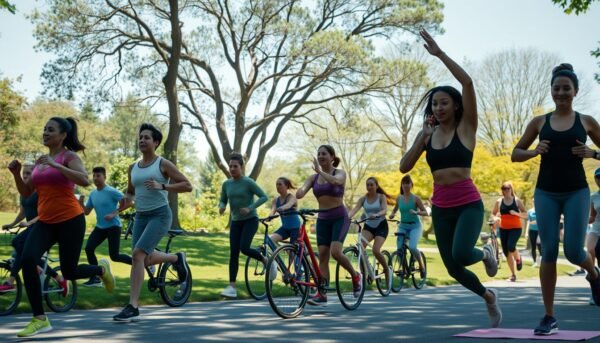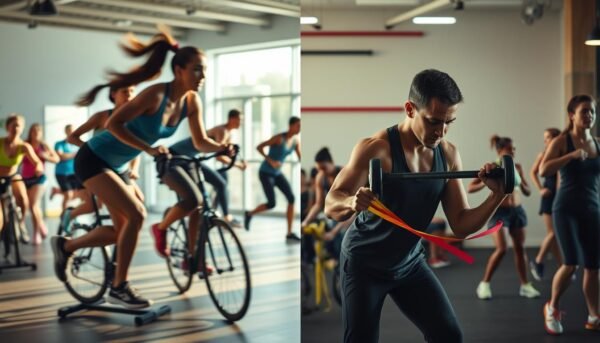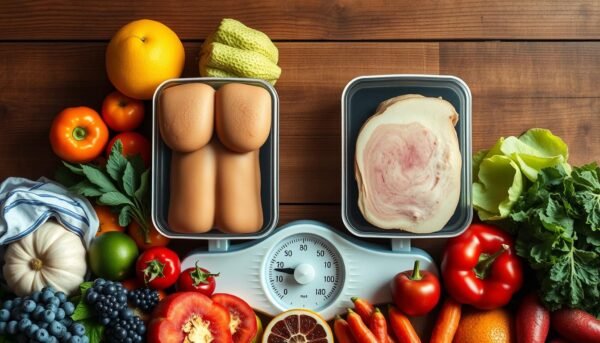Ever wondered how to lose weight for good? I’ve been on a fitness journey and I’m here to share my story. I ask a big question: Is it possible to lose weight and keep it off for good, or are the odds stacked against us?
Learning about weight loss, I found it’s not just quick fixes. It’s about understanding how our bodies work. I’ve learned that exercise, good food, and the right mindset help. This way, I lost weight and improved my health.
In this article, I’ll share what worked for me. We’ll talk about how exercise helps with weight loss. We’ll also look at the differences between aerobic and resistance training. My goal is to inspire you and help you start your own fitness journey.
The Impact of Exercise on Weight Loss
Exercise is key for weight loss, but it’s not everything. Studies show that exercise alone might not be enough. You might need up to 60 minutes a day to see weight loss from exercise alone.
The secret is understanding energy balance. This balance affects how we lose weight.
Energy Balance and Exercise Recommendations
Energy balance keeps our body stable. It’s about matching what we eat with how much we burn. Exercise is a big part of losing weight, but it’s hard to get it right.
Guidelines say we need at least 150 minutes of aerobic exercise a week. This helps us lose weight better.
Does Exercise Alone Contribute to Weight Loss?
Many studies have looked at exercise and weight loss. They found that exercise alone doesn’t do much. A study with 36 overweight people showed that exercise and diet together led to a 10% weight loss in 6 months.
Another study with 52 obese men found a 7.5 kg weight loss in 3 months with exercise alone. This suggests we might need more than 150 minutes a week of exercise to lose weight.
Exercise is important for health and can help with weight loss. But, the link between exercise and weight loss is complex. Things like how our bodies work and how we balance energy intake and expenditure matter a lot.

Aerobic Training vs. Resistance Training
The debate between aerobic exercise and resistance training for weight loss is ongoing. Aerobic exercise helps more with weight loss and fat reduction. But, adding resistance training also has benefits like keeping lean muscle and improving fitness.
Comparing Different Exercise Modalities
Exercise intensity and duration matter for weight loss. For example, weightlifting for 30 minutes burns around 110 calories. On the other hand, bicycling at a pace of 10 miles per hour or more burns about 295 calories in 30 minutes.
Resistance exercise boosts resting metabolic rate more than aerobic exercise alone. A study showed HIIT (High-Intensity Interval Training) burns 25–30% more calories than weight training, running, and biking.
Combining aerobic and resistance training is best for weight and fat loss. Adults need at least 150 minutes of moderate physical activity per week for health. For weight loss, do at least 30 minutes of cardiovascular exercise daily, aiming for 250 minutes (4 hours, 10 minutes) each week. Also, do an hour of strength training three to five times a week, resting at least one day between strength training days.

In summary, mixing aerobic and resistance training is the best for losing weight and fat. It helps reduce body fat, keeps lean muscle, and boosts fitness and metabolism.
weight and fat loss
Getting rid of extra weight and fat is hard. It needs a mix of diet and exercise to work well. Just cutting calories isn’t enough.
Muscle plays a big role in losing weight. Building muscle through exercise burns more calories. It also helps your body burn calories even when you’re not moving.
Studies show eating more protein helps lose fat and keep muscle. For example, a study found men eating more protein lost more fat and gained more muscle. They did this while working out a lot.
As we get older, losing muscle is common. But, eating enough protein and doing strength exercises can help. This fights off muscle loss, or sarcopenia.
| Recommendation | Details |
|---|---|
| Protein Intake | Adults should aim for 0.8 g of protein per kilogram of body weight to support muscle mass retention and fat loss during weight loss. |
| Exercise | Adults are recommended to get at least 150 to 300 minutes per week of cardio and muscle-strengthening activities to maintain muscle mass during weight loss. |
| Calorie Deficit | Creating a calorie deficit of 500 to 600 calories per day through diet and exercise can facilitate fat loss while minimizing muscle loss. |
To lose weight and fat well, focus on strength training. Eat enough protein and aim for a calorie deficit. This way, you’ll lose fat and keep your muscle.

Potential Explanations for Less Weight Loss Than Predicted
As I went on my weight loss journey, I found something puzzling. The weight I lost was less than I thought it would be. This made me curious about why this was happening.
The Role of Compensatory Eating and Individual Variability
Compensatory eating is a big factor in this. People might eat more to make up for the calories they burn from working out. This can stop them from losing weight as much as they thought.
Also, individual variability is key. Everyone reacts differently to exercise. Things like body type, how much you move around, and hormones can change how much weight you lose.
Studies show that the way we think about weight loss isn’t always right. Our bodies can change in ways that affect how much we lose. For example, moving less or burning fewer calories at rest can slow down weight loss.

Learning about these reasons has helped me understand weight loss better. I’m now looking for ways to improve my workout and diet. I also keep in mind that everyone is different.
Exercise and Weight Loss Maintenance
Keeping weight off can be hard, but exercise helps a lot. Studies show that people who move more, like 11-12 kcal/kg/day, keep weight off better. This is about 900 calories a day for an 81-kg woman.
Doing a mix of cardio and strength training is good for keeping weight off. Cardio, like walking fast or cycling, burns calories. Strength training keeps muscle, which helps your metabolism stay healthy.
Doing different activities helps burn calories and builds lasting habits. Sticking to a workout plan is key to keeping weight off.

What exercise is best for keeping weight off can change based on many things. Age, fitness level, and health matter. Talking to a doctor or fitness expert can help make a plan that fits you.
In short, moving regularly, with both cardio and strength training, is great for keeping weight off. By focusing on exercise and finding a balance, you can keep your weight in check and feel better overall.
Strength Training for Fat Loss
Strength training is a great way to lose fat and get a lean body. It burns calories during and after your workout. This helps you stay fit and toned.
Muscle Mass and Metabolism
Muscle burns calories even when you’re not moving. Building muscle through strength training boosts your metabolism. This helps you lose fat.
Studies show that full-body resistance training can reduce body fat by 1.4% in four weeks.
Building Muscle and Tracking Progress
Beginners gain muscle faster than more experienced people. A good strength training plan and a bit more food can help you grow muscle in 12-16 weeks. It’s important to track your progress with weight, reps, and body changes.
Being patient and consistent is key for muscle growth and fat loss. Make sure to rest and recover well between workouts for the best results.
| Strength Training Recommendations | Benefits |
|---|---|
|
|

The Journey to Fitness
Starting a fitness journey is exciting and tough. I’ve found that reaching my weight and fat loss goals has ups and downs. But seeing progress boosts my confidence and makes it all worth it.
Energy Level Fluctuations and Confidence Boosts
In the early days of my fitness journey, my energy levels changed a lot. Some days I felt full of energy, others I didn’t want to move. But sticking to my plan helped my energy levels get better. This made it easier to keep up with my workouts and boosted my confidence.
Overcoming Plateaus and Embracing Small Victories
Hit a plateau in your fitness journey? It happens to everyone. There were times when I didn’t see any changes on the scale. But I didn’t give up. Instead, I celebrated small wins like lifting heavier or wearing clothes that fit better.
By focusing on the good changes, I kept going. The journey has had its ups and downs. But the better energy levels, more confidence, and feeling accomplished make it all worth it.

Lifestyle Adaptations for Sustainable Fat Loss
Getting rid of excess fat is more than just diet and exercise changes. It’s about making lifestyle changes that last. This means cooking at home and managing stress, which affects your weight.
Slowly changing your daily habits can lead to lasting success. Aim to lose 1-2 pounds a week for a healthy pace. Losing 5% of your weight can lower heart disease and diabetes risks.
Don’t forget to stay active. The CDC says you need 150 minutes of aerobic activity and 2 days of strength training a week. Being active burns calories and helps keep weight off.
This post may contain affiliate links which means I may receive a commission for purchases made through links. I will only recommend products that I have personally used! Learn more on my Private Policy page.